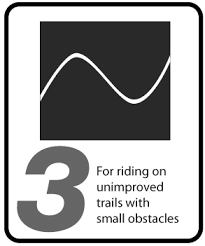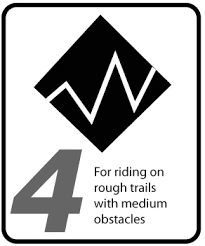Classification for Bicycle Usage
Any type of bicycle is designed and built for a specific usage condition. Its frame and components are designed and selected according to the stress they are expected to be subjected to within this condition. It is therefore of great importance to think about what conditions you are planning to ride in before you buy a new bicycle and to select a model accordingly.
If a bicycle is used in a higher category than defined for this bike by the manufacturer the stress on its materials will increase. This results in a shortened life span of all components and, in extreme cases, can lead to the failure of important components. This means an increased danger of accidents and injury. Therefore it is important to select a bicycle which intended usage condition covers the expected riding conditions.
Category
Description

Road: this category are designed for riding on hard-surface roads where the wheels remain in permanent contact to the ground. These are in general road racing bicycles with racing handlebars or straight handlebars, triathlon or time trial bicycles. The permissible maximum overall weight comprising rider, luggage and bicycle should not exceed 110 kg. Under certain circumstances this permissible maximum weight can be further limited by the component manufacturers’ recommendations for use. Proven cyclocross and gravel bikes with racing handlebars and cantilever or disc brakes are a special case in this category. In addition, these bikes are also suitable for gravel paths and off-road trails where a short loss of tyre contact with the ground due to small stairs or steps at a height of 15 to 20 cm can occur.
• INTENDED: To be ridden on paved roads only.
• NOT INTENDED: For off-road, cyclocross, or touring with racks or panniers.

Gravel: This is a set of conditions for the operation of a bicycle that includes Condition 1 as well as unpaved and gravel roads and trails with moderate grades. In this set of conditions, contact with irregular terrain and loss of tire contact with the ground may occur.
• INTENDED: For paved roads, gravel or dirt roads that are in good condition, and bike paths.
• NOT INTENDED: For off-road or mountain bike use, or for any kind of jumping. Some of these bikes have
suspension features, but these features are designed to add comfort, not off-road capability. Some come with
relatively wide tires that are well suited to gravel or dirt paths. Some come with relatively narrow tires that are best
suited to faster riding on pavement. If you ride on gravel or dirt paths, carry heavier loads or want more tire durability
talk to your dealer about wider tires.

XC/Trail: this category also covers the requirements of categories 1-2. It also includes use on more difficult and unpaved terrain. The capacity of these bikes includes occasional jumps up to a maximum height of 60 cm. Jumps of this magnitude can cause landing accidents for inexperienced cyclists, resulting in injuries, you need to know your abilities well and not push yourself beyond your limits. This category includes hardtail mountain bikes and short-travel full-suspension bikes
• INTENDED: For cross-country riding and racing which ranges from mild to aggressive over intermediate terrain
(e.g., hilly with small obstacles like roots, rocks, loose surfaces, hard pack and depressions). Cross-country and
marathon equipment (tires, shocks, frames, drive trains) are light-weight, favoring nimble speed over brute force.
Suspension travel is relatively short since the bike is intended to move quickly on the ground.
• NOT INTENDED: For Hardcore Freeriding, Extreme Downhill, Dirt Jumping, Slopestyle, or very aggressive or extreme riding. Not for spending time in the air, landing hard and hammering through obstacles.

AllMountain/Enduro : this category also covers the requirements of categories 1-3. In addition it includes use on very harsh, obstacle-scattered terrain with steep gradients and consequently higher speeds. This category is not suitable for regular use in bike parks and the “North Shore” sections. Due to frequent stress, these bikes should be inspected after each ride. Full suspension bikes with mid-level travel are typical in this category..
• INTENDED: For trail and uphill riding. All-Mountain/Enduro bicycles are: (1) more heavy duty than cross country bikes,
but less heavy duty than Freeride bikes, (2) lighter and more nimble than Freeride bikes, (3) heavier and have more
suspension travel than a cross country bike, allowing them to be ridden in more difficult terrain, over larger obstacles
and moderate jumps, (4) intermediate in suspension travel and use components that fit the intermediate intended
use, (5) cover a fairly wide range of intended use, with models that are more or less heavy duty.
• NOT INTENDED: For use in extreme forms of jumping/riding such as hardcore mountain, Freeriding, Downhill,
North Shore, Dirt Jumping, Hucking etc. Not for large drop offs, jumps or launches (wooden structures, dirt embankments) requirin

Freeride/Downhill: bicycles designed for jumping, hucking, high speeds, or aggressive riding on rougher surfaces, or
landing on flat surfaces. However, this type of riding is extremely hazardous and puts unpredictable forces on a
bicycle which may overload the frame, fork, or parts. If you choose to ride in Condition 5 terrain, you should take
appropriate safety precautions such as more frequent bike inspections and replacement of equipment. You should
also wear comprehensive safety equipment such as a full-face helmet, pads, and body armor.
• INTENDED: For riding that includes the most difficult terrain that only very skilled riders should attempt. Gravity,
Freeride, and Downhill are terms which describe hardcore mountain, north shore, slopestyle. This is “extreme” riding
and the terms describing it are constantly evolving.
Gravity, Freeride, and Downhill bikes are: (1) heavier and have more suspension travel than All-Mountain bikes, allowing them to be ridden in more difficult terrain, over larger obstacles and larger jumps, (2) the longest in suspension travel and use components that fit heavy duty intended use. There is no guarantee that extreme riding will not break a Freeride bike.
Warning: The terrain and type of riding that Freeride bikes are designed for is inherently dangerous. Appropriate equipment, such as a Freeride bike, does not change this reality. In this kind of riding, bad judgment, bad luck, or riding beyond your capabilities can easily result in an accident, where you could be seriously injured, paralyzed or killed.
We try to combine maximum performance with low weight and maximum durability in our products. The result is high-end mountain bikes that require proper and regular care and service. If these works are not performed at all or incorrectly, small defects can cause costly and sometimes dangerous consequential damage. Weather and riding conditions determine how often you need to clean and service your bike. For example: a hard day of riding in extremely muddy and wet conditions means you’ll need to clean, lubricate and at least carefully inspect your bike at the end of the session. The right set of good quality tools and the knowledge of how to use them are essential here. If you have any doubts, contact us and we will be at your disposal for any clarification.
The specifications mentioned above show some limitations that should help you understand and judge different conditions of use. Furthermore, it is also clear that the riding technique – especially if not fully developed – and the weight of the cyclist, as well as the quantity and intensity of use, are important factors when it comes to stress and can easily shift the boundaries between two or more serious. of the conditions. If your technique or riding style are not yet well developed, even a jump of a few centimeters can cause severe stress to the bicycle and lead to falls with all the unwanted effects that usually result. Train your riding skills to be safer, take care of your bike and learn to become less demanding with your equipment.
We strongly advise you to constantly check the following areas of the frame:
_down tube/low side head tube intersection
_oblique tube/horizontal tube intersection
_horizontal tube intersection with top side head tube
_shock absorber brackets with end welds in the upper and lower areas
_crossing between vertical tube and horizontal tube
_seat tube end area
_connecting rod supports
_low rear area of the seat tube
_low chainstays with joke in particular the lower area and internal area
These are the most stressed points of the frames and which should be constantly checked, even more if the frame is used in a condition not covered on its intended use category.
All of the above has the primary aim of protecting your safety and secondly to ensure that you can extend the useful life of your frame as much as possible.
